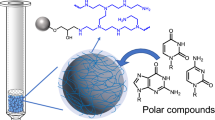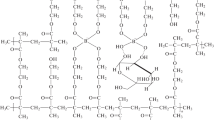Abstract
Highly cross-linked macroporous polymers were prepared utilizing ethylene dimethacrylate as a cross-linking agent, in the presence or absence of methyl-α-D-glucoside as a kind of template molecule with methacrylic acid as a functional monomer. After the preparation of the polymers, we applied a high temperature to the cross-linked polymers to study the changes of adsorption properties of the polymers for sugar derivatives including the template molecule utilized. Interestingly, the heat treatment up to 250˚C afforded improvement of relative adsorption affinity for several sugar derivatives including the template molecule, while heat treatment up to 150˚C did not afford those improvements. The detailed studies including polymers prepared using acrylic acid as a functional monomer instead of methacrylic acid prove that temperatures higher than the Tg temperature of the polymer derived from a functional monomer such as methacrylic acid and higher than the melting point (mp) of the sugar template are necessary to afford the observed improvement of relative affinity based on the surface modification effects through the heat treatment to cross-linked polymers.
Similar content being viewed by others
References
E. M. Thurman and M. S. Mills, “Solid-Phase Extraction”, 1998, John Wiley & Sons, Inc., New York.
H. Kawaguchi, “Advanced Technology of Microspheres and Powders”, 2000, CMC, Tokyo.
J. Ugelstad, H. R. Mfutakamba, P. C. Mork, T. Ellingsen, A. Berge, R. Schmid, L. Holm, A. Jorgedal, F. K. Hansen, and K. Nustad, J. Polym. Sci., Polymer Symposium, 1985, 72, 225.
K. Kimata, K. Hosoya, and N. Tanaka, Bunseki, 1992, 450.
J. Haginaka, K. Hosoya, and K. Kimata, Bunseki, 1997, 474.
N. Tanaka, T. Ebata, K. Hashizume, K. Hosoya, and M. Araki, J. Chromatogr., 1989, 475, 195.
K. Jinno, “Chromatographic separations based on molecular recognition”, 1997, Wiley-VCH, New York.
K. Hosoya, K. Kimata, T. Araki, N. Tanaka, and J. M. J. Frechet, Anal. Chem., 1995, 67, 1907.
K. Hosoya and N. Tanaka, in “HPLC Polymer-based Packing Materials”, ed. H. Kawaguchi, Tokyo, 2000.
K. Hosoya, K. Yoshizako, N. Tanaka, K. Kimata, T. Araki, and J. M. J. Frechet, J. Chromatogr. A, 1994, 666, 449.
B. Sellergren, in “Moleculary Imprinted Polymers”, Amsterdam, 2001.
J. Haginaka, H. Takehira, K. Hosoya, and N. Tanaka, J. Chromatogr. A, 1999, 849, 331.
D. D. Perrin, W. L. F. Armarego, and D. R. Perrin, “Purification of Laboratory Chemicals”, 1980, Pergamon Press, Oxford.
B. Sellergren and K. J. Shea, J. Chromatogr., 1993, 635, 31.
Y. Kihira and H. Yamamura, Makromol. Chem., 1985, 186, 423.
Author information
Authors and Affiliations
Corresponding author
Rights and permissions
About this article
Cite this article
Hosoya, K., Yoshizako, K., Kubo, T. et al. Selective Surface Modification Technique for Improvement of Chromatographic Separation Selectivity for Sugar Derivatives. ANAL. SCI. 18, 55–58 (2002). https://doi.org/10.2116/analsci.18.55
Received:
Accepted:
Published:
Issue Date:
DOI: https://doi.org/10.2116/analsci.18.55




